A Healthy Park Needs Healthy Vegetation: The Story of Gorongosa National Park in the 21st Century
Abstract
1. Introduction
2. Materials and Methods
2.1. Study Area
2.2. Vegetation Change Characteristics
2.2.1. Mean NDVI
2.2.2. Seasonal Precipitation Totals
2.2.3. Vegetation Directional Persistence
3. Results
3.1. Precipitation Anomolies and Trends
3.2. Changes of NDVI
3.3. Tendencies in Vegetation Directional Persistence
4. Discussion
5. Conclusions
Author Contributions
Funding
Acknowledgments
Conflicts of Interest
References
- Chapin, F.S., III; Matson, P.A.; Vitousek, P. Principles of Terrestrial Ecosystem Ecology; Springer: New York, NY, USA, 2011. [Google Scholar]
- Hanan, N.; Lehmann, C. Tree–Grass Interactions in Savannas: Paradigms, Contradictions, and Conceptual Models. Available online: https://www.taylorfrancis.com/books/e/9780429132469/chapters/10.1201%2Fb10275-10 (accessed on 23 September 2019).
- Scholes, R.J.; Walker, B.H. An. African savanna: Synthesis of the Nylsvley Study; Cambridge University Press: Cambridge, UK, 1993. [Google Scholar]
- Andela, N.; Liu, Y.Y.; Van Dijk, A.I.J.M.; De Jeu, R.A.M.; McVicar, T.R. Global changes in dryland vegetation dynamics (1988–2008) assessed by satellite remote sensing: Comparing a new passive microwave vegetation density record with reflective greenness data. Biogeosciences 2013, 10, 6657–6676. [Google Scholar] [CrossRef]
- Campo-Bescos, M.A.; Munoz-Carpena, R.; Kaplan, D.A.; Southworth, J.; Zhu, L.; Waylen, P.R. Beyond Precipitation: Physiographic Gradients Dictate the Relative Importance of Environmental Drivers on Savanna Vegetation. PLoS ONE 2013, 8, e72348. [Google Scholar] [CrossRef]
- Lehmann, C.E.; Anderson, T.M.; Sankaran, M.; Higgins, S.I.; Archibald, S.; Hoffmann, W.A.; Hanan, N.P.; Williams, R.J.; Fensham, R.J.; Felfili, J.; et al. Savanna Vegetation-Fire-Climate Relationships Differ Among Continents. Science 2014, 343, 548–552. [Google Scholar] [CrossRef] [PubMed]
- Sankaran, M.; Hanan, N.P.; Scholes, R.J.; Ratnam, J.; Augustine, D.J.; Cade, B.S.; Gignoux, J.; Higgins, S.I.; Le Roux, X.; Ludwig, F.; et al. Determinants of woody cover in African savannas. Nature 2005, 438, 846–849. [Google Scholar] [CrossRef] [PubMed]
- Scholes, R.J.; Archer, S.R. Tree-Grass Interactions in Savannas. Annu. Rev. Ecol. Syst. 1997, 28, 517–544. [Google Scholar] [CrossRef]
- Staver, A.C.; Archibald, S.; Levin, S. Tree cover in sub-Saharan Africa: Rainfall and fire constrain forest and savanna as alternative stable states. Ecology 2011, 92, 1063–1072. [Google Scholar] [CrossRef]
- De Jong, R.; Verbesselt, J.; Zeileis, A.; Schaepman, M.E. Shifts in Global Vegetation Activity Trends. Remote Sens. 2013, 5, 1117–1133. [Google Scholar] [CrossRef]
- Jung, M.; Reichstein, M.; Ciais, P.; Seneviratne, S.I.; Sheffield, J.; Goulden, M.L.; Bonan, G.; Cescatti, A.; Chen, J.; De Jeu, R.; et al. Recent decline in the global land evapotranspiration trend due to limited moisture supply. Nature 2010, 467, 951–954. [Google Scholar] [CrossRef]
- Bunting, E.L.; Fullman, T.; Kiker, G.; Southworth, J. Utilization of the SAVANNA model to analyze future patterns of vegetation cover in Kruger National Park under changing climate. Ecol. Model. 2016, 342, 147–160. [Google Scholar] [CrossRef]
- Houghton, E. Climate Change 1995: The Science of Climate Change: Contribution of Working Group I to the Second Assessment Report of the Intergovernmental Panel on Climate Change; Cambridge University Press: Cambridge, UK, 1996. [Google Scholar]
- Houghton, R.A.; Hackler, J.L.; Lawrence, K.T. The U.S. Carbon Budget: Contributions from Land-Use Change. Science 1999, 285, 574–578. [Google Scholar] [CrossRef]
- Monserud, R.A.; Tchebakova, N.M.; Leemans, R. Global vegetation change predicted by the modified Budyko model. Clim. Chang. 1993, 25, 59–83. [Google Scholar] [CrossRef]
- Ojima, D.S.; Valentine, D.W.; Mosier, A.R.; Parton, W.J.; Schimel, D.S. Effect of land use change on methane oxidation in temperate forest and grassland soils. Chemosphere 1993, 26, 675–685. [Google Scholar] [CrossRef]
- Scholes, R.J.; Hall, D.O. The carbon budget of tropical savannas, woodlands, and grasslands. SCOPE-Sci. Comm. Probl. Environ. Int. Counc. Sci. Unions 1996, 56, 69–100. [Google Scholar]
- Child, B. Zimbabwe’s CAMPFIRE programme: Using the high value of wildlife recreation to revolutionize natural resource management in communal areas. Commonw. For. Rev. 1993, 72, 284–296. [Google Scholar]
- Waylen, P.; Southworth, J.; Gibbes, C.; Tsai, H. Time Series Analysis of Land Cover Change: Developing Statistical Tools to Determine Significance of Land Cover Changes in Persistence Analyses. Remote Sens. 2014, 6, 4473–4497. [Google Scholar] [CrossRef]
- Southworth, J.; Zhu, L.; Bunting, E.; Ryan, S.J.; Herrero, H.; Waylen, P.R.; Hill, M.J. Changes in vegetation persistence across global savanna landscapes, 1982–2010. J. Land Use Sci. 2016, 11, 7–32. [Google Scholar] [CrossRef]
- Carlson, T.N.; Ripley, D.A. On the relation between NDVI, fractional vegetation cover, and leaf area index. Remote Sens. Environ. 1997, 62, 241–252. [Google Scholar] [CrossRef]
- Bégué, A.; Vintrou, E.; Ruelland, D.; Claden, M.; Dessay, N. Can a 25-year trend in Soudano-Sahelian vegetation dynamics be interpreted in terms of land use change? A remote sensing approach. Glob. Environ. Chang. 2011, 21, 413–420. [Google Scholar] [CrossRef]
- Jiang, Z.; Huete, A.R.; Chen, J.; Chen, Y.; Li, J.; Yan, G.; Zhang, X. Analysis of NDVI and scaled difference vegetation index retrievals of vegetation fraction. Remote Sens. Environ. 2006, 101, 366–378. [Google Scholar] [CrossRef]
- Lambin, E.F.; Ehrlich, D. Land-cover changes in sub-saharan Africa (1982–1991): Application of a change index based on remotely sensed surface temperature and vegetation indices at a continental scale. Remote Sens. Environ. 1997, 61, 181–200. [Google Scholar] [CrossRef]
- Tucker, C.J. Red and photographic infrared linear combinations for monitoring vegetation. Remote Sens. Environ. 1979, 8, 127–150. [Google Scholar] [CrossRef]
- Wang, J.; Rich, P.M.; Price, K.P.; Kettle, W.D. Relations between NDVI, Grassland Production, and Crop Yield in the Central Great Plains. Geocarto Int. 2005, 20, 5–11. [Google Scholar] [CrossRef]
- Müller, T.; Mapaura, A.; Wursten, B.; Chapano, C.; Ballings, P.; Wild, R. Vegetation Survey of Mount Gorongosa. Available online: http://dev.gorongosa.forumone.com/sites/default/files/research/041-bfa_no.23_gorongosa_vegetation_survey.pdf (accessed on 30 January 2020).
- Rahbek, C.; Borregaard, M.K.; Colwell, R.K.; Dalsgaard, B.; Holt, B.G.; Morueta-Holme, N.; Nogues-Bravo, D.; Whittaker, R.J.; Fjeldså, J. Humboldt’s enigma: What causes global patterns of mountain biodiversity? Science 2019, 365, 1108–1113. [Google Scholar] [CrossRef] [PubMed]
- Gorongosa National Park Website. Available online: www.gorongosa.org (accessed on 30 January 2020).
- Adams, P. Opinion | A Comeback for African National Parks. Available online: https://www.nytimes.com/2019/02/20/opinion/africa-national-parks.html (accessed on 30 January 2020).
- Tinley, K.L. Framework of the Gorongosa Ecosystem. Available online: https://www.gorongosa.org/our-story/science/reports/framework-gorongosa-ecosystem (accessed on 30 January 2020).
- Daskin, J.H.; Stalmans, M.; Pringle, R.M. Ecological legacies of civil war: 35-year increase in savanna tree cover following wholesale large-mammal declines. J. Anim. Ecol. 2016, 104, 79–89. [Google Scholar] [CrossRef]
- Herrero, H.V.; Southworth, J.; Bunting, E.; Child, B. Using Repeat Photography to Observe Vegetation Change Over Time in Gorongosa National Park. Available online: https://geog.ufl.edu/2017/06/26/using-repeat-photography-to-observe-vegetation-change-over-time-in-gorongosa-national-park/ (accessed on 30 January 2020).
- DeFries, R.; Hansen, A.; Turner, B.L.; Reid, R.; Liu, J. Land Use Change Around Protected Areas: Management to Balance Human Needs and Ecological Function. Ecol. Appl. 2007, 17, 1031–1038. [Google Scholar] [CrossRef] [PubMed]
- Measuring Vegetation (NDVI & EVI). Available online: https://earthobservatory.nasa.gov/features/MeasuringVegetation (accessed on 24 September 2019).
- Funk, C.; Peterson, P.; Landsfeld, M.; Pedreros, D.; Verdin, J.; Shukla, S.; Husak, G.; Rowland, J.; Harrison, L.; Hoell, A.; et al. The climate hazards infrared precipitation with stations—a new environmental record for monitoring extremes. Sci. Data 2015, 2, 1–21. [Google Scholar] [CrossRef] [PubMed]
- Nicholson, S.E. The nature of rainfall variability over Africa on time scales of decades to millenia. Glob. Planet. Chang. 2000, 26, 137–158. [Google Scholar] [CrossRef]
- Dezfuli, A.K.; Zaitchik, B.F.; Gnanadesikan, A. Regional Atmospheric Circulation and Rainfall Variability in South Equatorial Africa. J. Clim. 2014, 28, 809–818. [Google Scholar] [CrossRef]
- Zhu, L.; Southworth, J. Disentangling the Relationships between Net Primary Production and Precipitation in Southern Africa Savannas Using Satellite Observations from 1982 to 2010. Remote Sens. 2013, 5, 3803–3825. [Google Scholar] [CrossRef]
- 3.2 Hypergeometric Distribution, 3.5, 3.9 Mean and Variance. Available online: http://www.math.ucsd.edu/~gptesler/186/slides/186_hypergeom_17-handout.pdf (accessed on 30 January 2020).
- Jeltsch, F.; Weber, G.E.; Grimm, V. Ecological buffering mechanisms in savannas: A unifying theory of long-term tree-grass coexistence. Plant. Ecol. 2000, 150, 161–171. [Google Scholar] [CrossRef]
- Campbell, A.; Child, G. The Impact of Man on the Environment of Botswana. Botsw. Notes Rec. 1971, 3, 91–110. [Google Scholar]
- Child, G. An Ecological Survey of Northeastern Botswana; Food and Agriculture Organization of the United Nations: Rome, Italy, 1968. [Google Scholar]
- Herrero, H.V.; Southworth, J.; Bunting, E. Utilizing Multiple Lines of Evidence to Determine Landscape Degradation within Protected Area Landscapes: A Case Study of Chobe National Park, Botswana from 1982 to 2011. Remote Sens. 2016, 8, 623. [Google Scholar] [CrossRef]
- Moleele, N.M.; Ringrose, S.; Matheson, W.; Vanderpost, C. More woody plants? the status of bush encroachment in Botswana’s grazing areas. J. Environ. Manag. 2002, 64, 3–11. [Google Scholar] [CrossRef] [PubMed]
- Ringrose, S.; Matheson, W.; Wolski, P.; Huntsman-Mapila, P. Vegetation cover trends along the Botswana Kalahari transect. J. Arid Environ. 2003, 54, 297–317. [Google Scholar] [CrossRef]
- Van Wilgen, B.W.; Govender, N.; Biggs, H.C.; Ntsala, D.; Funda, X.N. Response of Savanna Fire Regimes to Changing Fire-Management Policies in a Large African National Park. Conserv. Biol. 2004, 18, 1533–1540. [Google Scholar] [CrossRef]
- Vitousek, P.M.; Mooney, H.A.; Lubchenco, J.; Melillo, J.M. Human Domination of Earth’s Ecosystems. Science 1997, 277, 494–499. [Google Scholar] [CrossRef]
- Wells, M.; Bradon, K. People and Parks: Linking Protected Area Management with Local Communities; World Bank: Washington, DC, USA, 1992. [Google Scholar]
- Sayer, J. Rainforest Buffer Zones: Guidelines for Protected Area Managers; International Union for Conservation of Nature and Natural Resources: Gland, Switzerland, 1991. [Google Scholar]
- Martino, D. Buffer Zones Around Protected Areas: A Brief Literature Review. Available online: https://escholarship.org/content/qt02n4v17n/qt02n4v17n.pdf (accessed on 30 January 2020).
- De Jong, R.; de Bruin, S.; de Wit, A.; Schaepman, M.E.; Dent, D.L. Analysis of monotonic greening and browning trends from global NDVI time-series. Remote Sens. Environ. 2011, 115, 692–702. [Google Scholar] [CrossRef]
- De Jong, R.; Verbesselt, J.; Schaepman, M.E.; De Bruin, S. Trend changes in global greening and browning: Contribution of short-term trends to longer-term change. Glob. Chang. Biol. 2012, 18, 642–655. [Google Scholar] [CrossRef]
- Mitchard, E.T.; Saatchi, S.S.; Gerard, F.F.; Lewis, S.L.; Meir, P. Measuring Woody Encroachment along a Forest–Savanna Boundary in Central Africa. Earth Interact. 2009, 13, 1–29. [Google Scholar] [CrossRef]
- Piao, S.; Wang, X.; Ciais, P.; Zhu, B.; Wang, T.A.O.; Liu, J.I.E. Changes in satellite-derived vegetation growth trend in temperate and boreal Eurasia from 1982 to 2006. Glob. Chang. Biol. 2011, 17, 3228–3239. [Google Scholar] [CrossRef]
- Guay, K.C.; Beck, P.S.; Berner, L.T.; Goetz, S.J.; Baccini, A.; Buermann, W. Vegetation productivity patterns at high northern latitudes: A multi-sensor satellite data assessment. Glob. Chang. Biol. 2014, 20, 3147–3158. [Google Scholar] [CrossRef] [PubMed]
- Brandt, M.; Mbow, C.; Diouf, A.A.; Verger, A.; Samimi, C.; Fensholt, R. Ground- and satellite-based evidence of the biophysical mechanisms behind the greening Sahel. Glob. Chang. Biol. 2015, 21, 1610–1620. [Google Scholar] [CrossRef] [PubMed]
- Schimel, D.; Pavlick, R.; Fisher, J.B.; Asner, G.P.; Saatchi, S.; Townsend, P.; Miller, C.; Frankenberg, C.; Hibbard, K.; Cox, P. Observing terrestrial ecosystems and the carbon cycle from space. Glob. Chang. Biol. 2015, 21, 1762–1776. [Google Scholar] [CrossRef] [PubMed]
- Garonna, I.; de Jong, R.; Schaepman, M.E. Variability and evolution of global land surface phenology over the past three decades (1982–2012). Glob. Chang. Biol. 2016, 22, 1456–1468. [Google Scholar] [CrossRef] [PubMed]
- Bastin, J.F.; Berrahmouni, N.; Grainger, A.; Maniatis, D.; Mollicone, D.; Moore, R.; Patriarca, C.; Picard, N.; Sparrow, B.; Abraham, E.M.; et al. The extent of forest in dryland biomes. Science 2017, 356, 635–638. [Google Scholar] [CrossRef] [PubMed]
- Olsson, L.; Eklundh, L.; Ardö, J. A recent greening of the Sahel—trends, patterns and potential causes. J. Arid Environ. 2005, 63, 556–566. [Google Scholar] [CrossRef]
- Zhang, K.; Kimball, J.S.; Nemani, R.R.; Running, S.W.; Hong, Y.; Gourley, J.J.; Yu, Z. Vegetation Greening and Climate Change Promote Multidecadal Rises of Global Land Evapotranspiration. Sci. Rep. 2015, 5, 15956. [Google Scholar] [CrossRef]
- Zhu, Z.; Piao, S.; Myneni, R.B.; Huang, M.; Zeng, Z.; Canadell, J.G.; Ciais, P.; Sitch, S.; Friedlingstein, P.; Arneth, A.; et al. Greening of the Earth and its drivers. Nat. Clim. Chang. 2016, 6, 791–795. [Google Scholar] [CrossRef]
- Alcaraz-Segura, D.O.; Chuvieco, E.; Epstein, H.E.; Kasischke, E.S.; Trishchenko, A. Debating the greening vs. browning of the North American boreal forest: Differences between satellite datasets. Glob. Chang. Biol. 2010, 16, 760–770. [Google Scholar] [CrossRef]
- Cunliffe, R.; Lynam, T. Preliminary Vegetation Classification and Mapping of Gorongosa National Park, Sofala Province, Mozambique. Available online: https://www.gorongosa.org/sites/default/files/research/018-cunliffe_lynam_veg._classification_and_mapping_1-05.pdf (accessed on 30 January 2020).
- Stalmans, M. Tinley’s Plant Species List for the Greater Gorongosa Ecosystem. Available online: http://dev.gorongosa.forumone.com/sites/default/files/research/052-stalmans_tinley_plant_species_list_gorongosa.pdf (accessed on 30 January 2020).
- Stalmans, M.; Beilfuss, R. Long-Term Plan for Gorongosa National Park Vegetation Monitoring at Multiple Scales. Available online: https://www.researchgate.net/profile/Richard_Beilfuss/publication/313728082_Long-term_plan_for_Gorongosa_National_Park_vegetation_monitoring_at_multiple_scales/links/58a43c59a6fdcc0e0751a8a0/Long-term-plan-for-Gorongosa-National-Park-vegetation-monitoring-at-multiple-scales.pdf (accessed on 30 January 2020).
- Stalmans, M.; Beilfuss, R. Landscapes of the Gorongosa National Park. Available online: https://www.researchgate.net/publication/314878798_Landscapes_of_the_Gorongosa_National_Park (accessed on 30 January 2020).
- Barnes, M.D.; Glew, L.; Wyborn, C.; Craigie, I.D. Prevent perverse outcomes from global protected area policy. Nat. Ecol. Evol. 2018, 2, 759–762. [Google Scholar] [CrossRef]
- Fuller, R.A.; McDonald-Madden, E.; Wilson, K.A.; Carwardine, J.; Grantham, H.S.; Watson, J.E.; Klein, C.J.; Green, D.C.; Possingham, H.P. Replacing underperforming protected areas achieves better conservation outcomes. Nature 2010, 466, 365–367. [Google Scholar] [CrossRef]
- Newmark, W.D. Insularization of Tanzanian Parks and the Local Extinction of Large Mammals. Conserv. Biol. 1996, 10, 1549–1556. [Google Scholar] [CrossRef]
- Rodrigues, A.S.; Andelman, S.J.; Bakarr, M.I.; Boitani, L.; Brooks, T.M.; Cowling, R.M.; Fishpool, L.D.; Da Fonseca, G.A.; Gaston, K.J.; Hoffmann, M.; et al. Effectiveness of the global protected area network in representing species diversity. Nature 2004, 428, 640–643. [Google Scholar] [CrossRef]
- Saura, S.; Bertzky, B.; Bastin, L.; Battistella, L.; Mandrici, A.; Dubois, G. Protected area connectivity: Shortfalls in global targets and country-level priorities. Biol. Conserv. 2018, 219, 53–67. [Google Scholar] [CrossRef] [PubMed]
- De Almeida, A.S.; Stone, T.A.; Vieira, I.C.G.; Davidson, E.A. Nonfrontier Deforestation in the Eastern Amazon. Earth Interact. 2010, 14, 1–15. [Google Scholar] [CrossRef]
- Ingram, J.C.; Dawson, T.P. Technical Note: Inter-annual analysis of deforestation hotspots in Madagascar from high temporal resolution satellite observations. Int. J. Remote Sens. 2005, 26, 1447–1461. [Google Scholar] [CrossRef]
- Jin, Y.; Sung, S.; Lee, D.K.; Biging, G.S.; Jeong, S. Mapping Deforestation in North Korea Using Phenology-Based Multi-Index and Random Forest. Remote Sens. 2016, 8, 997. [Google Scholar] [CrossRef]
- Kumar, P.; Rani, M.; Pandey, P.C.; Majumdar, A.; Nathawat, M.S. Monitoring of Deforestation and Forest Degradation Using Remote Sensing and GIS: A Case Study of Ranchi in Jharkhand (India). Available online: https://s3.amazonaws.com/academia.edu.documents/27495816/03_2578_report0204_14_20.pdf?response-content-disposition=inline%3B%20filename%3DMonitoring_of_deforestation_and_forest_d.pdf&X-Amz-Algorithm=AWS4-HMAC-SHA256&X-Amz-Credential=AKIAIWOWYYGZ2Y53UL3A%2F20200130%2Fus-east-1%2Fs3%2Faws4_request&X-Amz-Date=20200130T055501Z&X-Amz-Expires=3600&X-Amz-SignedHeaders=host&X-Amz-Signature=77313dbc5b0b67d184a938083b116a87b73bdd2929f6bcdf96b205283ea987b6 (accessed on 30 January 2020).
- Lunetta, R.S.; Knight, J.F.; Ediriwickrema, J.; Lyon, J.G.; Worthy, L.D. Land-cover change detection using multi-temporal MODIS NDVI data. Remote Sens. Environ. 2006, 105, 142–154. [Google Scholar] [CrossRef]
- Manoharan, V.S.; Welch, R.M.; Lawton, R.O. Impact of deforestation on regional surface temperatures and moisture in the Maya lowlands of Guatemala. Geophys. Res. Lett. 2009, 36. [Google Scholar] [CrossRef]
- Senay, G.B.; Elliott, R.L. Combining AVHRR-NDVI and landuse data to describe temporal and spatial dynamics of vegetation. For. Ecol. Manag. 2000, 128, 83–91. [Google Scholar] [CrossRef]
- Sobrino, J.A.; Julien, Y. Global trends in NDVI-derived parameters obtained from GIMMS data. Int. J. Remote Sens. 2011, 32, 4267–4279. [Google Scholar] [CrossRef]
- Van der Werf, G.R.; Morton, D.C.; DeFries, R.S.; Giglio, L.; Randerson, J.T.; Collatz, G.J.; Kasibhatla, P.S. Estimates of fire emissions from an active deforestation region in the southern Amazon based on satellite data and biogeochemical modelling. Biogeosciences 2009, 6, 235–249. [Google Scholar] [CrossRef]
- Walsh, S.J.; Crawford, T.W.; Welsh, W.F.; Crews-Meyer, K.A. A multiscale analysis of LULC and NDVI variation in Nang Rong district, northeast Thailand. Agric. Ecosyst. Environ. 2001, 85, 47–64. [Google Scholar] [CrossRef]
- Guyton, J.A.; Pansu, J.; Hutchinson, M.C.; Kartzinel, T.R.; Potter, A.B.; Coverdale, T.C.; Daskin, J.H.; da Conceição, A.G.; Peel, M.J.; Stalmans, M.E.; et al. Trophic rewilding revives biotic resistance to shrub invasion. Nat. Ecol. Evol. 2020, 1–13. [Google Scholar] [CrossRef] [PubMed]

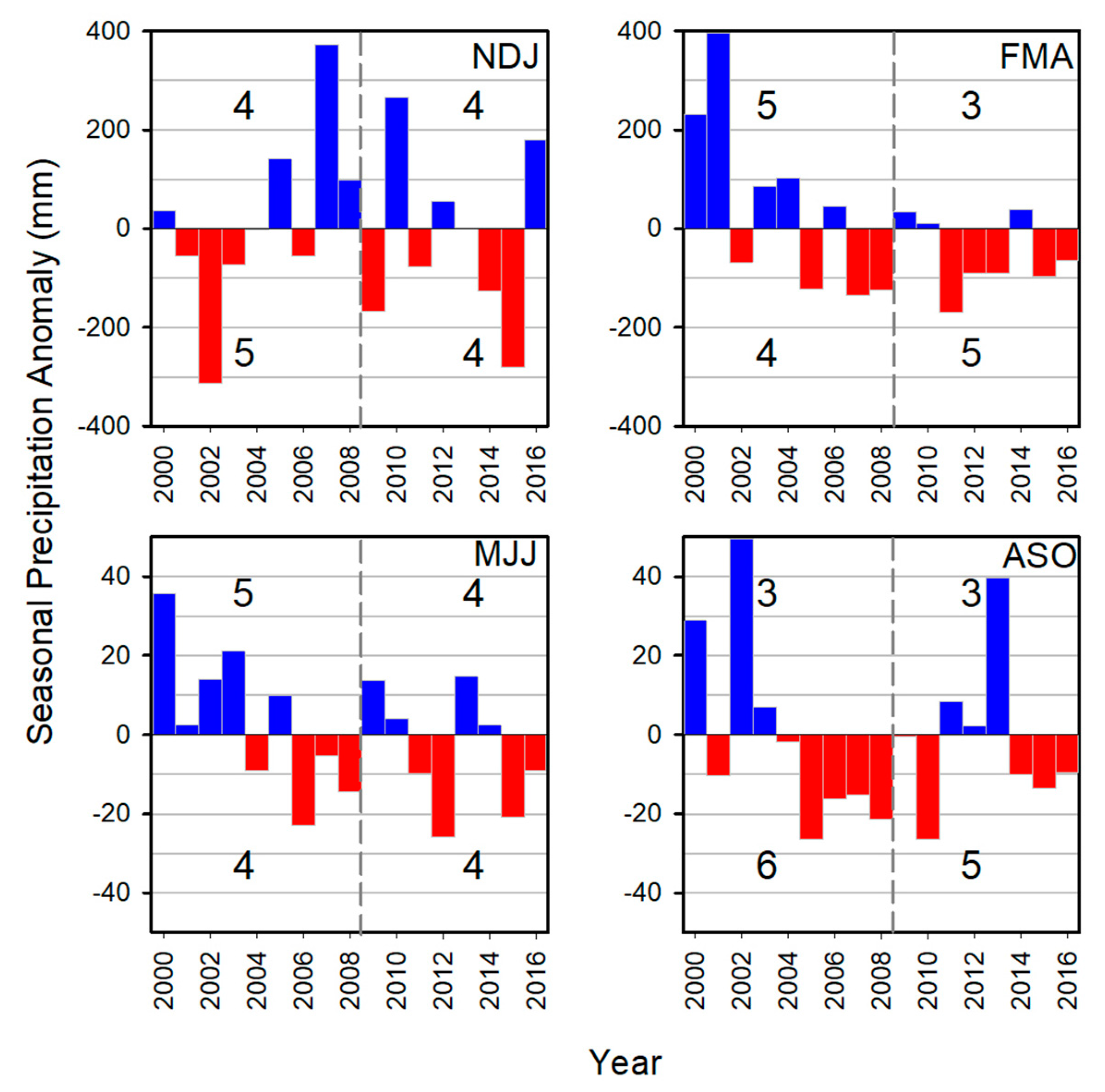

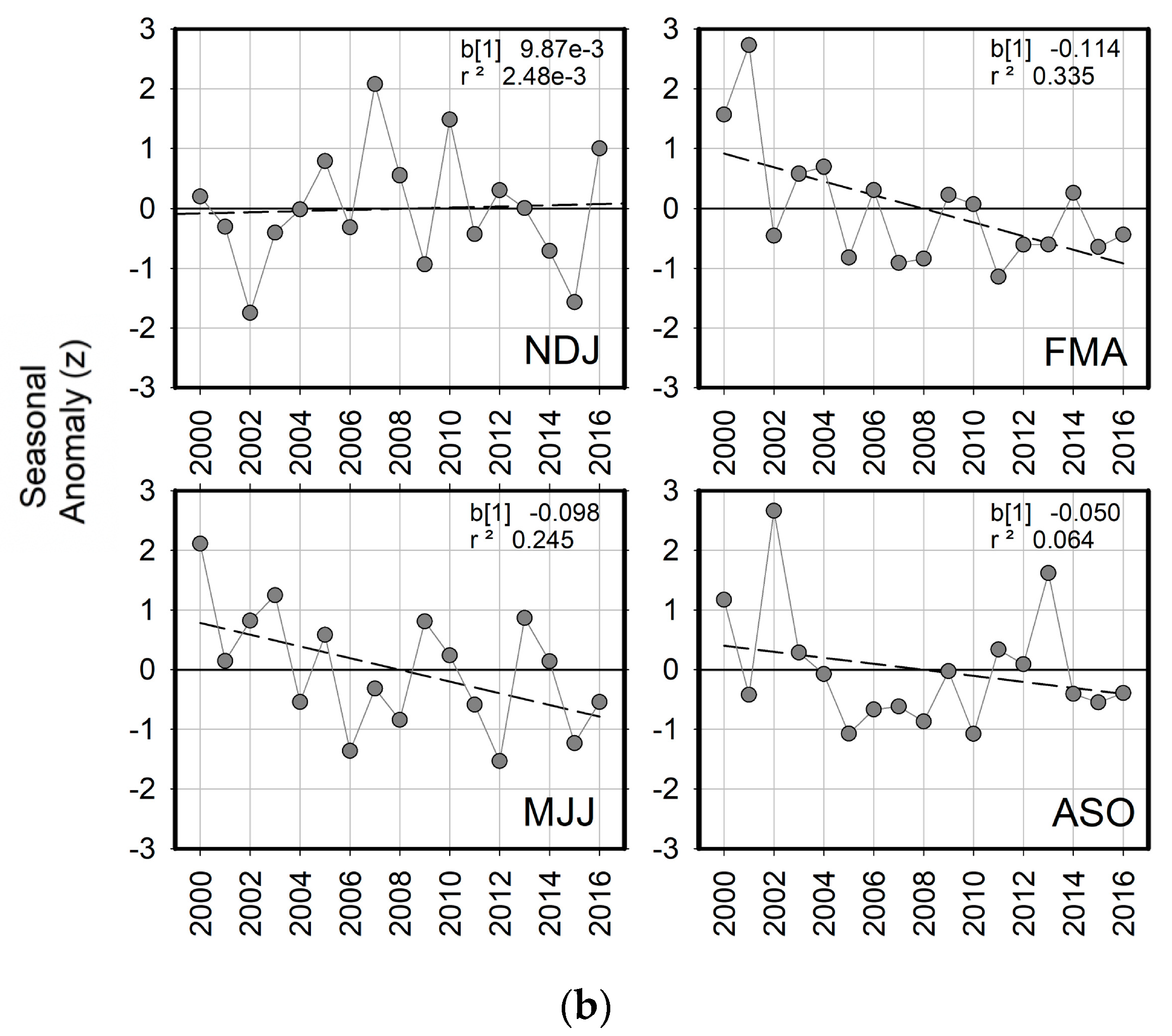
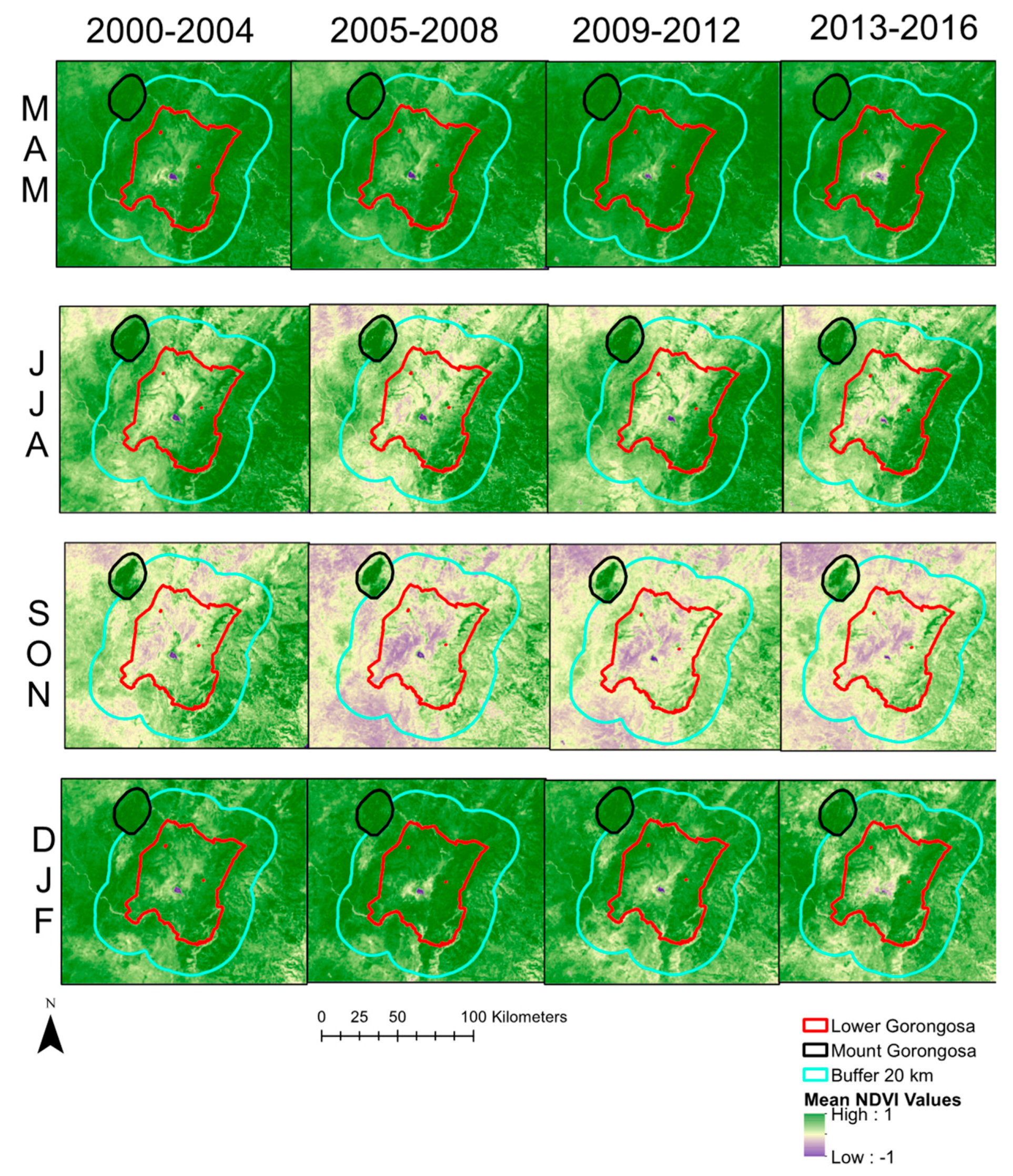
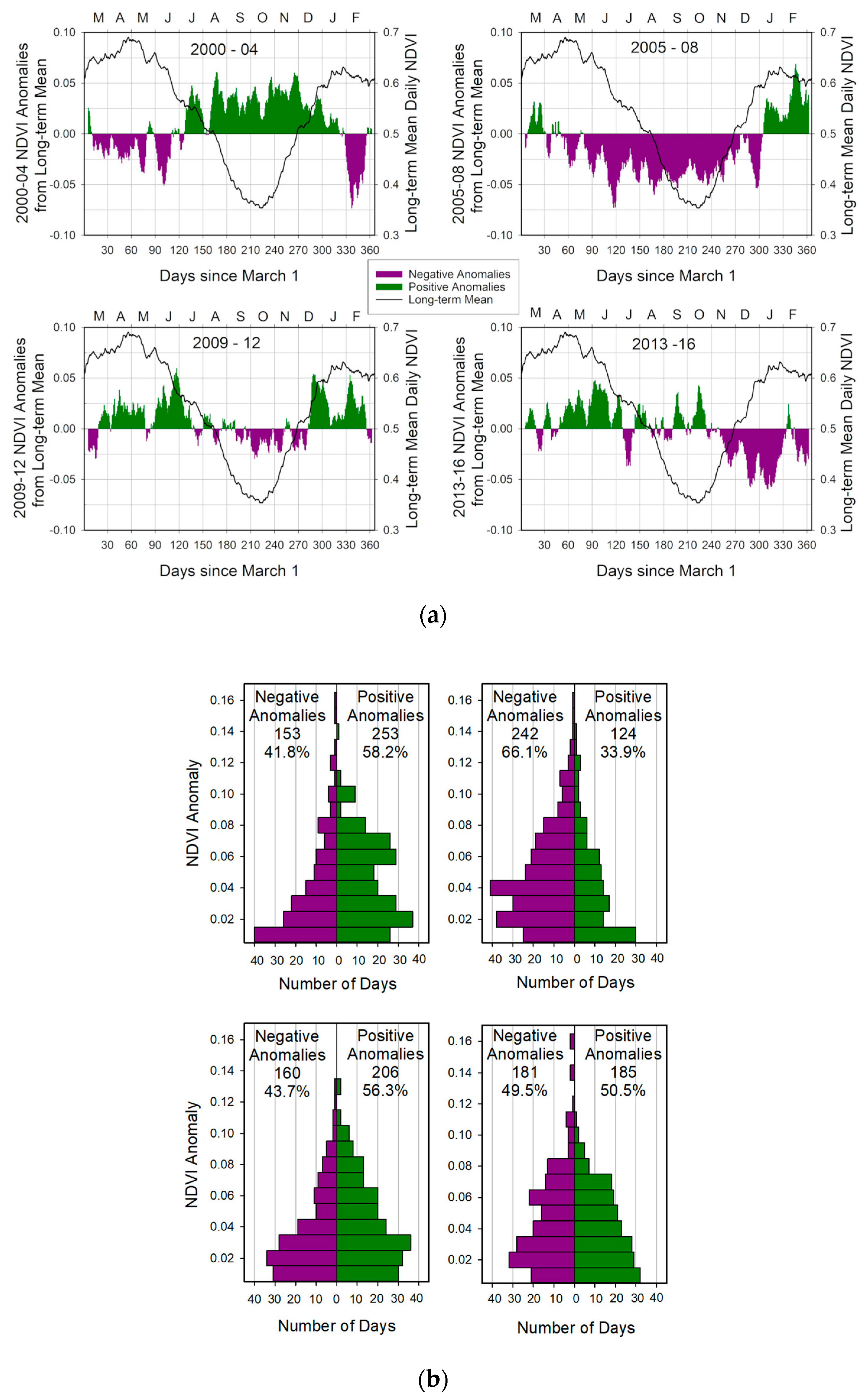
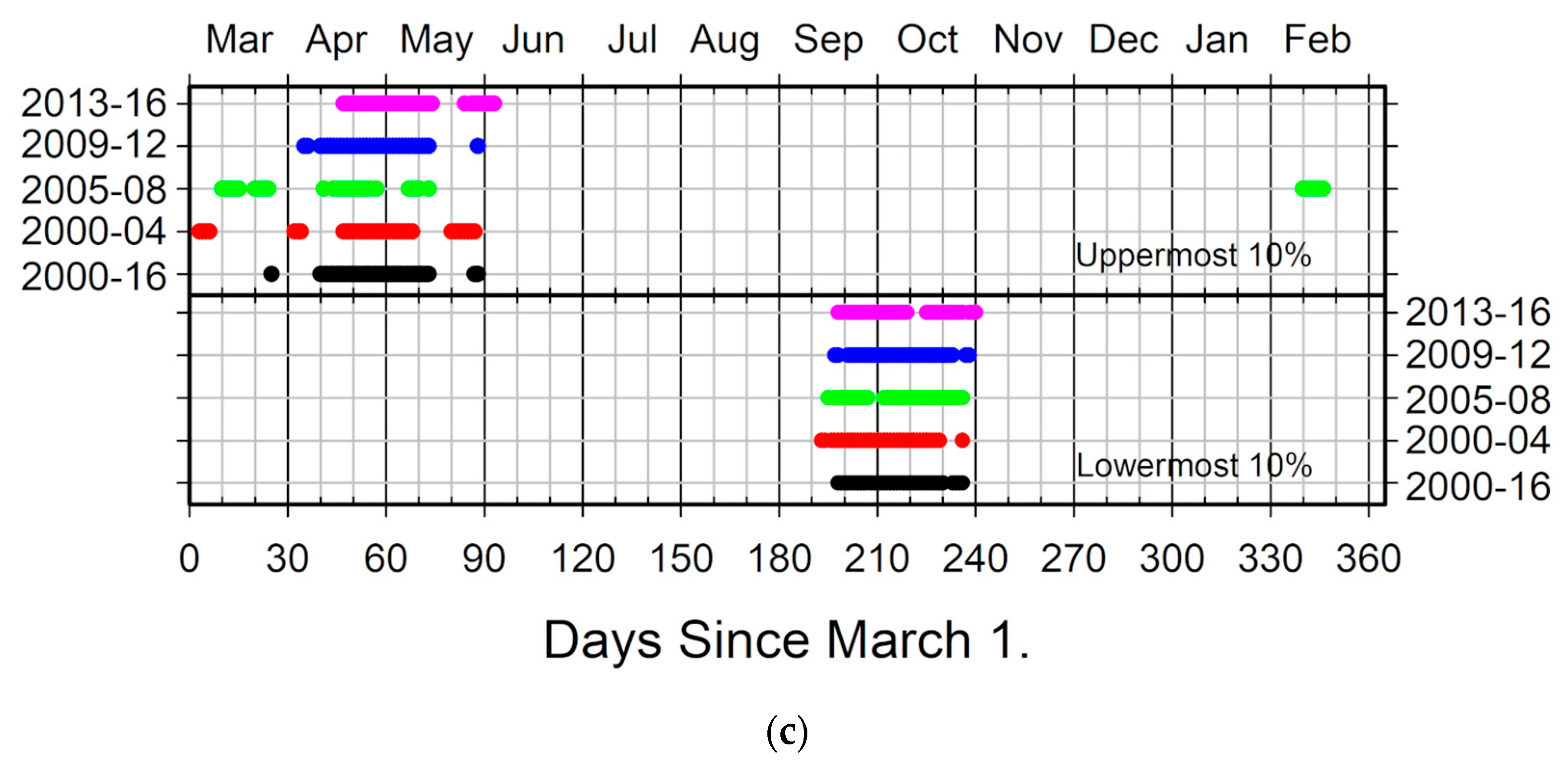
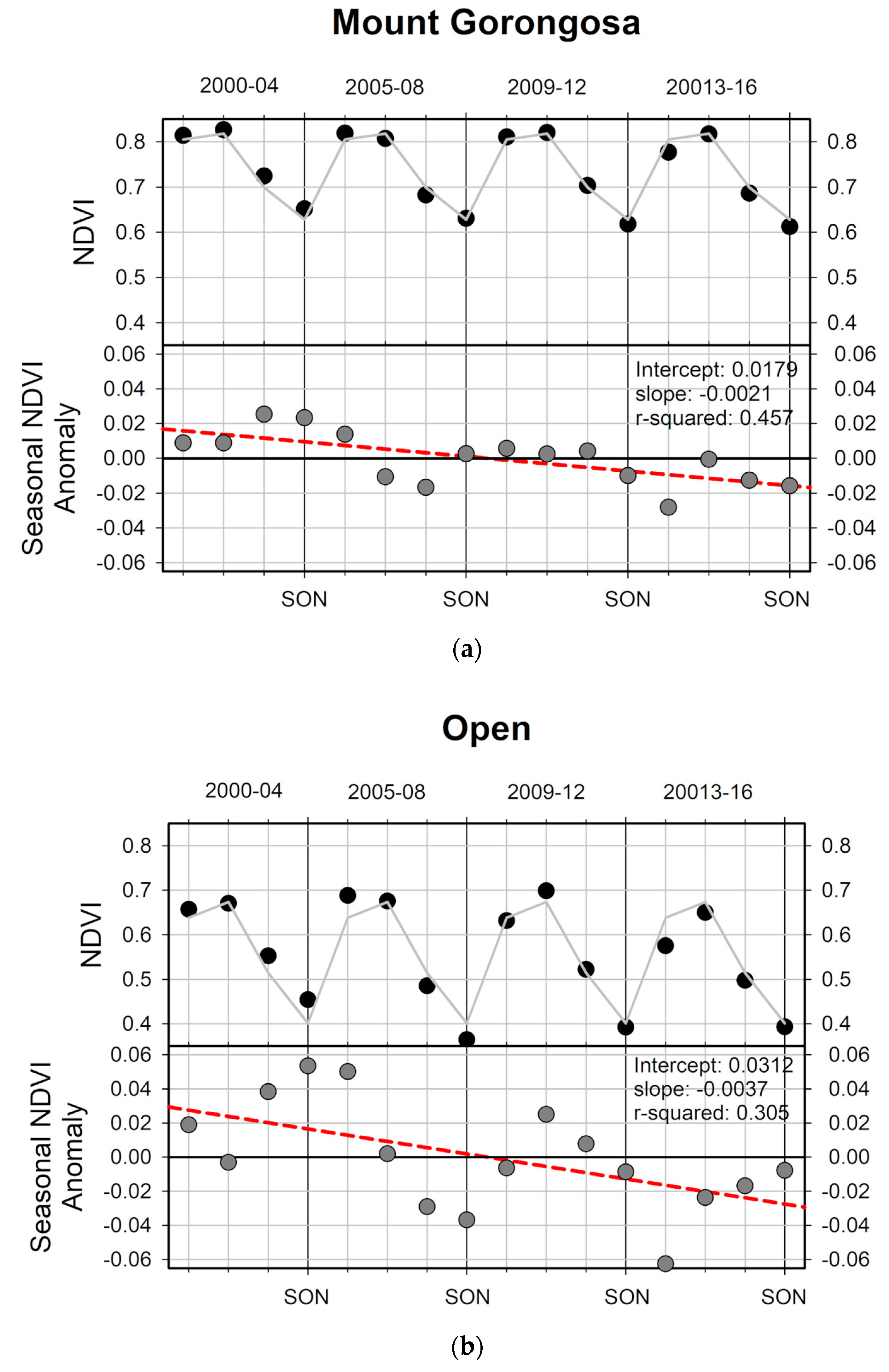
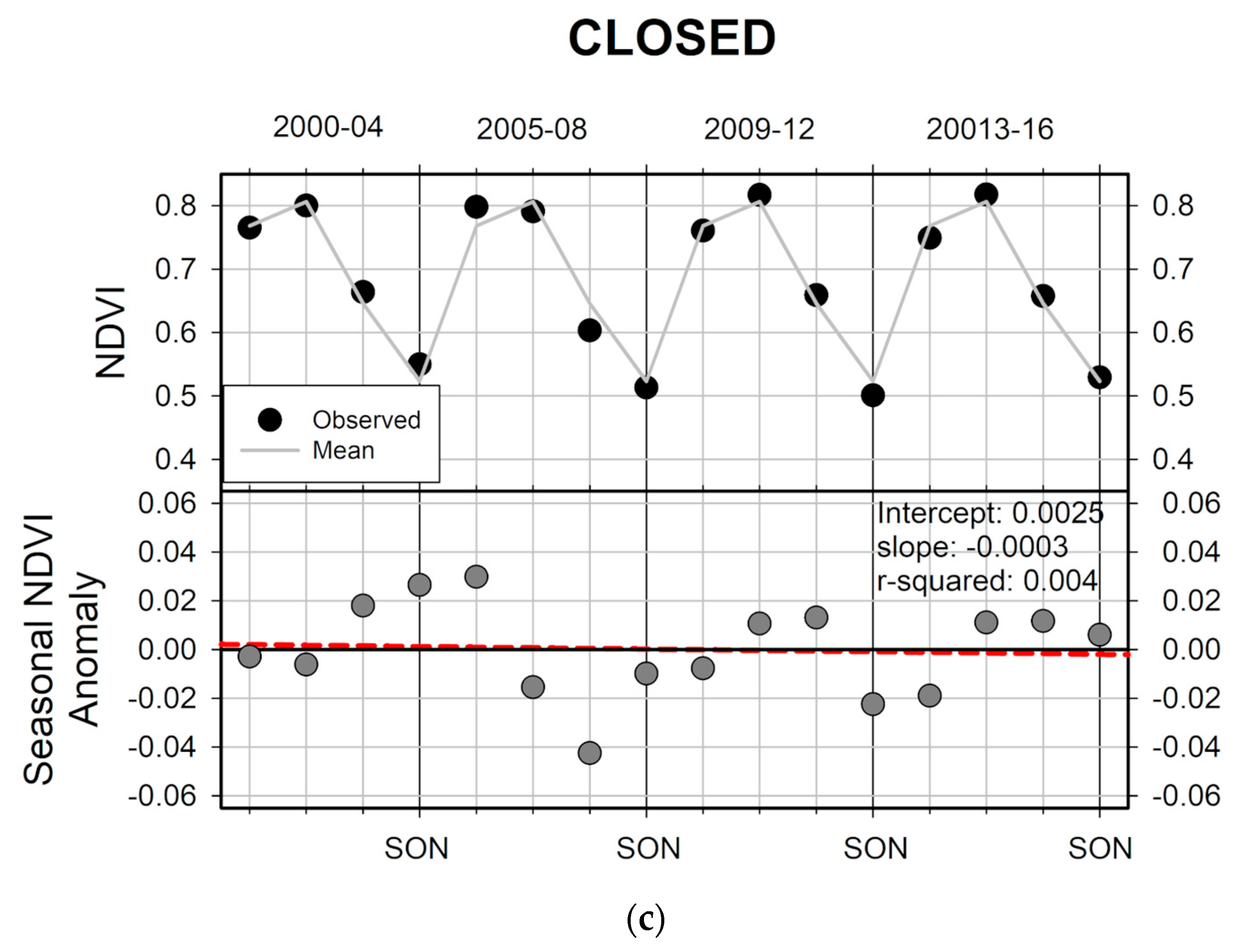

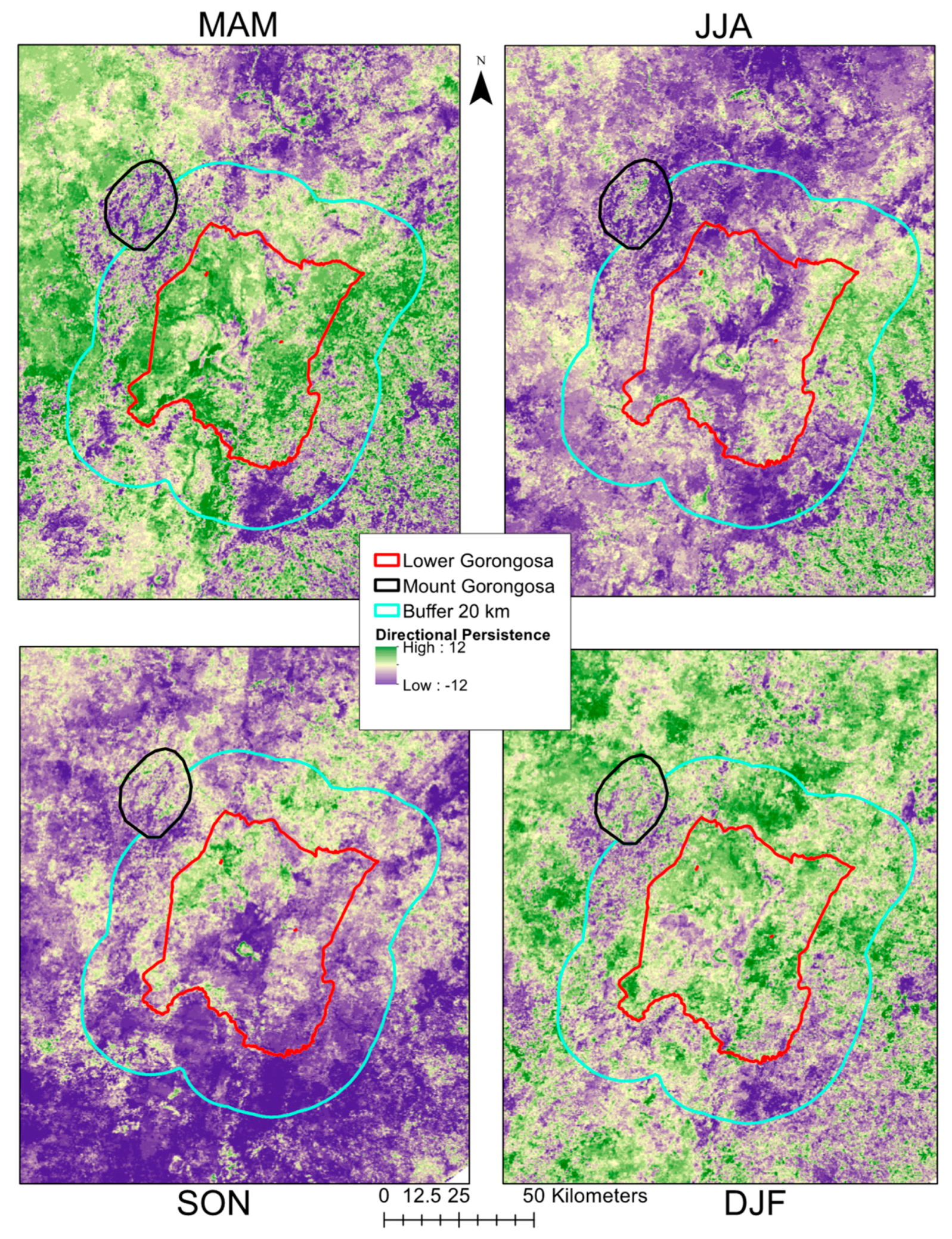

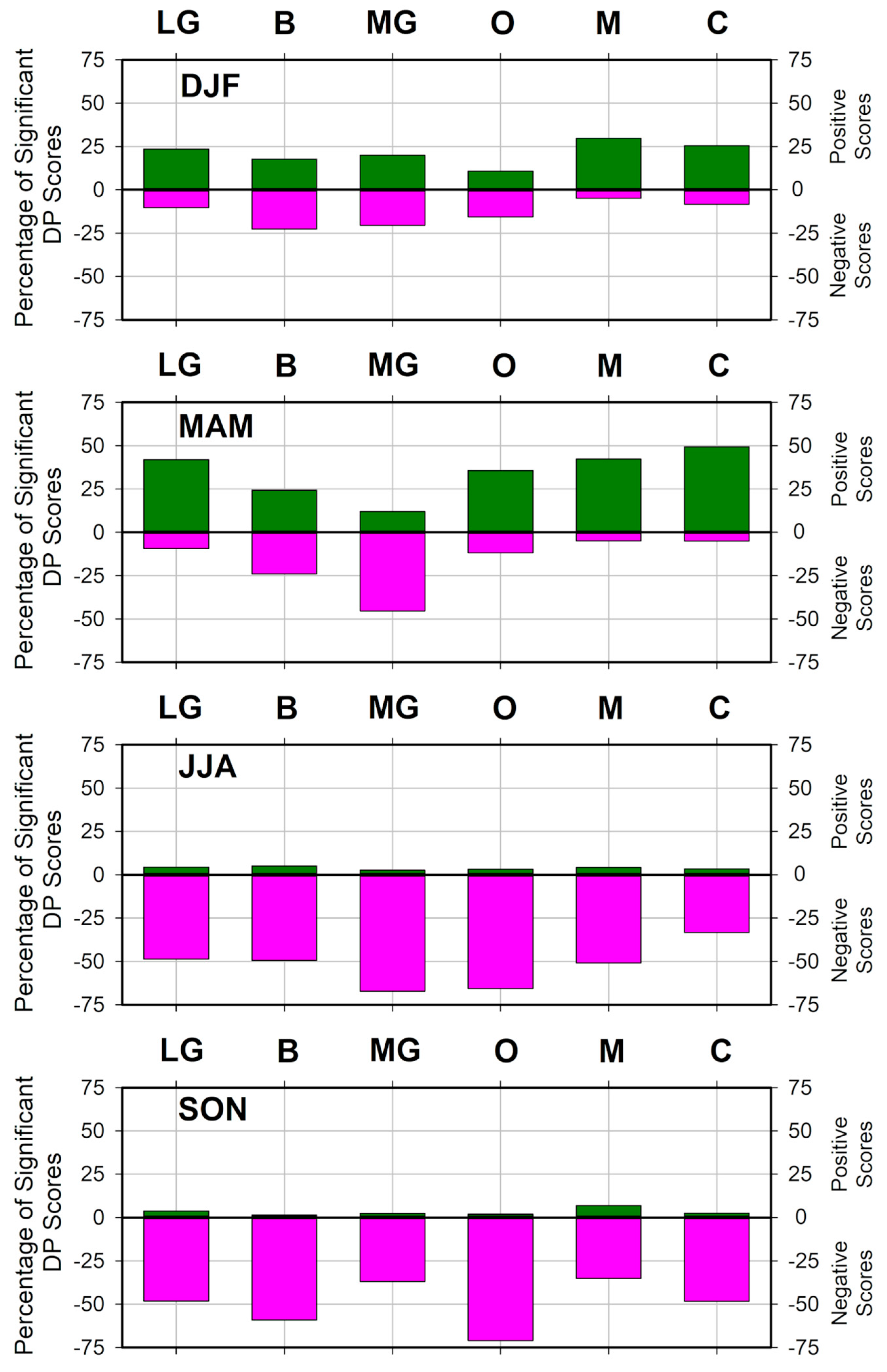
© 2020 by the authors. Licensee MDPI, Basel, Switzerland. This article is an open access article distributed under the terms and conditions of the Creative Commons Attribution (CC BY) license (http://creativecommons.org/licenses/by/4.0/).
Share and Cite
Herrero, H.; Waylen, P.; Southworth, J.; Khatami, R.; Yang, D.; Child, B. A Healthy Park Needs Healthy Vegetation: The Story of Gorongosa National Park in the 21st Century. Remote Sens. 2020, 12, 476. https://doi.org/10.3390/rs12030476
Herrero H, Waylen P, Southworth J, Khatami R, Yang D, Child B. A Healthy Park Needs Healthy Vegetation: The Story of Gorongosa National Park in the 21st Century. Remote Sensing. 2020; 12(3):476. https://doi.org/10.3390/rs12030476
Chicago/Turabian StyleHerrero, Hannah, Peter Waylen, Jane Southworth, Reza Khatami, Di Yang, and Brian Child. 2020. "A Healthy Park Needs Healthy Vegetation: The Story of Gorongosa National Park in the 21st Century" Remote Sensing 12, no. 3: 476. https://doi.org/10.3390/rs12030476
APA StyleHerrero, H., Waylen, P., Southworth, J., Khatami, R., Yang, D., & Child, B. (2020). A Healthy Park Needs Healthy Vegetation: The Story of Gorongosa National Park in the 21st Century. Remote Sensing, 12(3), 476. https://doi.org/10.3390/rs12030476








